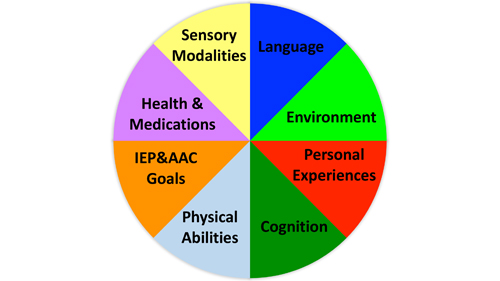The Bridge School and Environment
The Bridge School education program currently serves 14 students with complex communication needs and severe physical impairments often associated with cerebral palsy who require the use of Augmentative and Alternative Communication (AAC) systems. Our service delivery model is an interdisciplinary educational team that includes a special education teacher, speech language pathologist, occupational therapist, assistive technologist and several instructional assistants. For students diagnosed with CVI, a teacher of the visually impaired (TVI) typically serves as a consultant for the delivery of services and recommended interventions within our ongoing curriculum.
Research has shown myopia, cortical visual impairment (CVI), strabismus and gaze dysfunction co-occur in 70% of children who have severe physical impairments associated with cerebral palsy. Thirty percent of these children are diagnosed with CVI (Ghasia, Brunstrom, Gordon, & Tychsen, 2008) and it is the “fastest growing visual impairment diagnosis today” (American Printing House for the Blind, What is CVI?). At The Bridge School, approximately 50% of our students have received a diagnosis of cortical visual impairment.
In order to address the needs of our students, it was necessary for our staff to learn as much as possible about CVI, to determine how to integrate effective intervention strategies throughout the school day and to develop appropriate goals and objectives for inclusion in the students’ educational plan.

The Need for a CVI Assessment
While (CVI) identification begins as a medical issue, it becomes an educational issue….

While these recommendations established the basic parameters for intervention, the individual and unique needs of a student with CVI and SSPI changed throughout the school year. The availability of a CVI assessment that could support development of accommodations and interventions as the school year progressed and that also kept pace with a student’s development, was important. Assessments that addressed language, communication, academics, assistive technology and augmented alternative communication were already available to The Bridge School team and they guided interventions as a student’s needs changed. The critical missing element was a process to assess why and how vision accommodations should be designed and when they should change. This was necessary to create and present learning scaffolds that were current and designed to meet the needs of each student. Most importantly, teachers and SLPs needed the tools to assess how a student’s CVI impacts their education and how it contributes to overall language and communication development.


